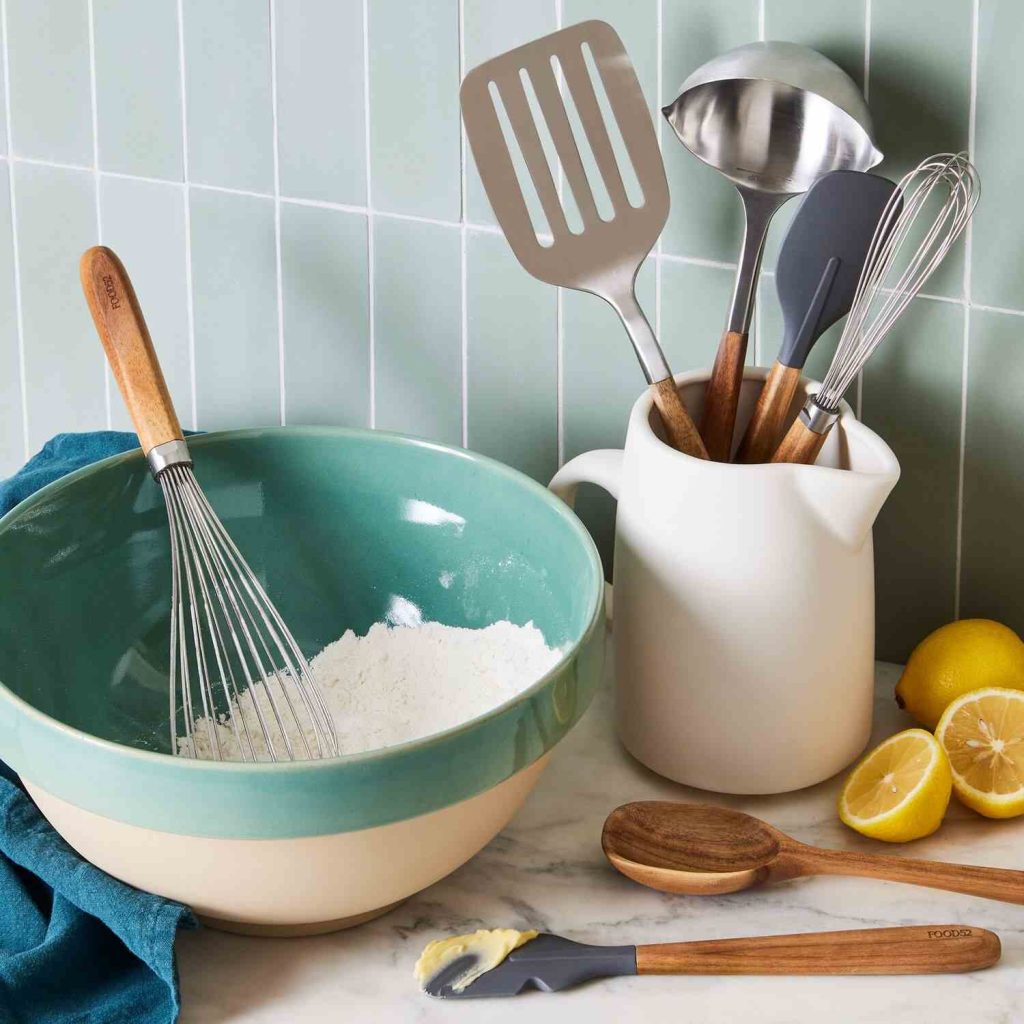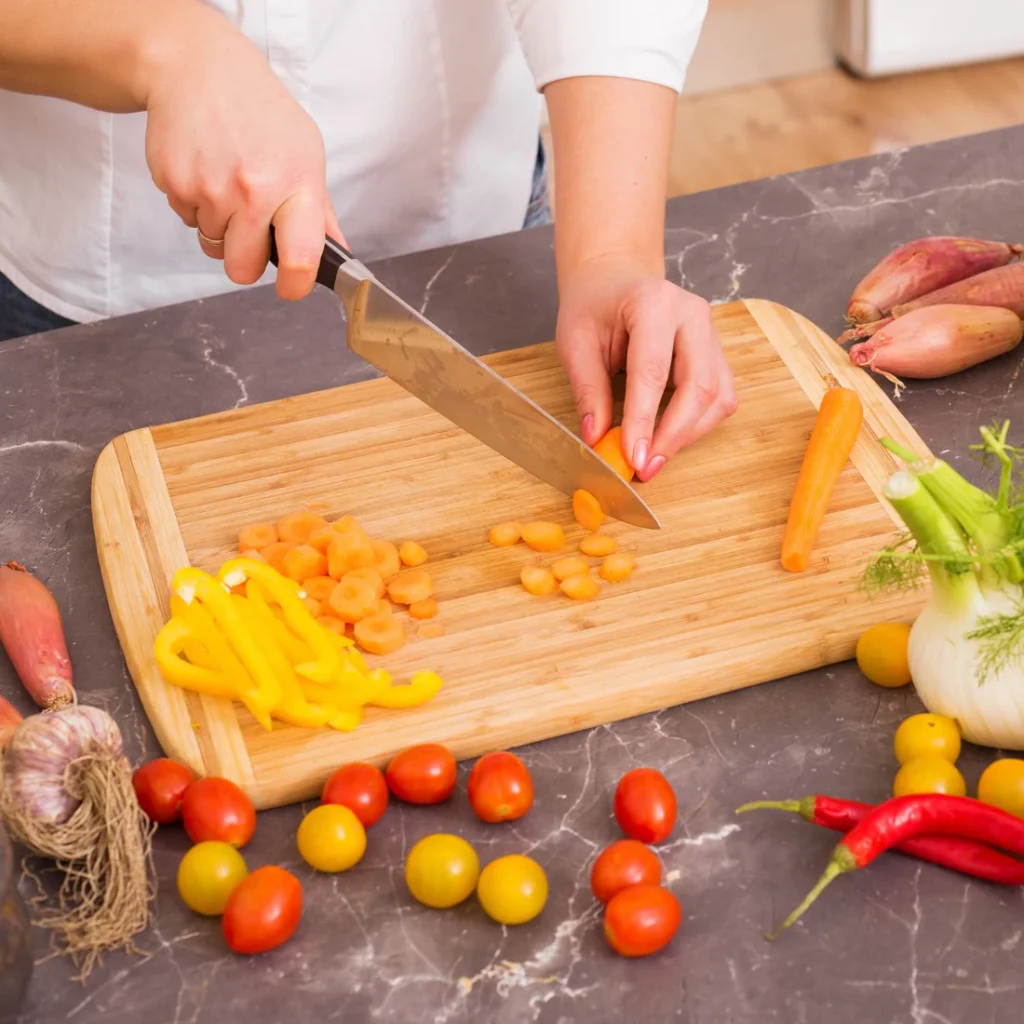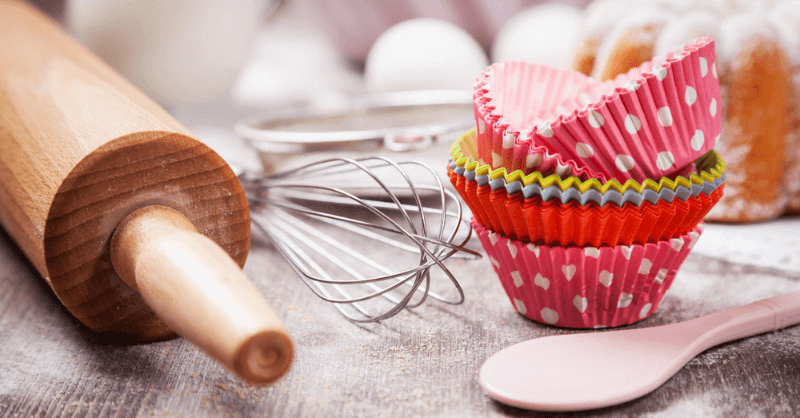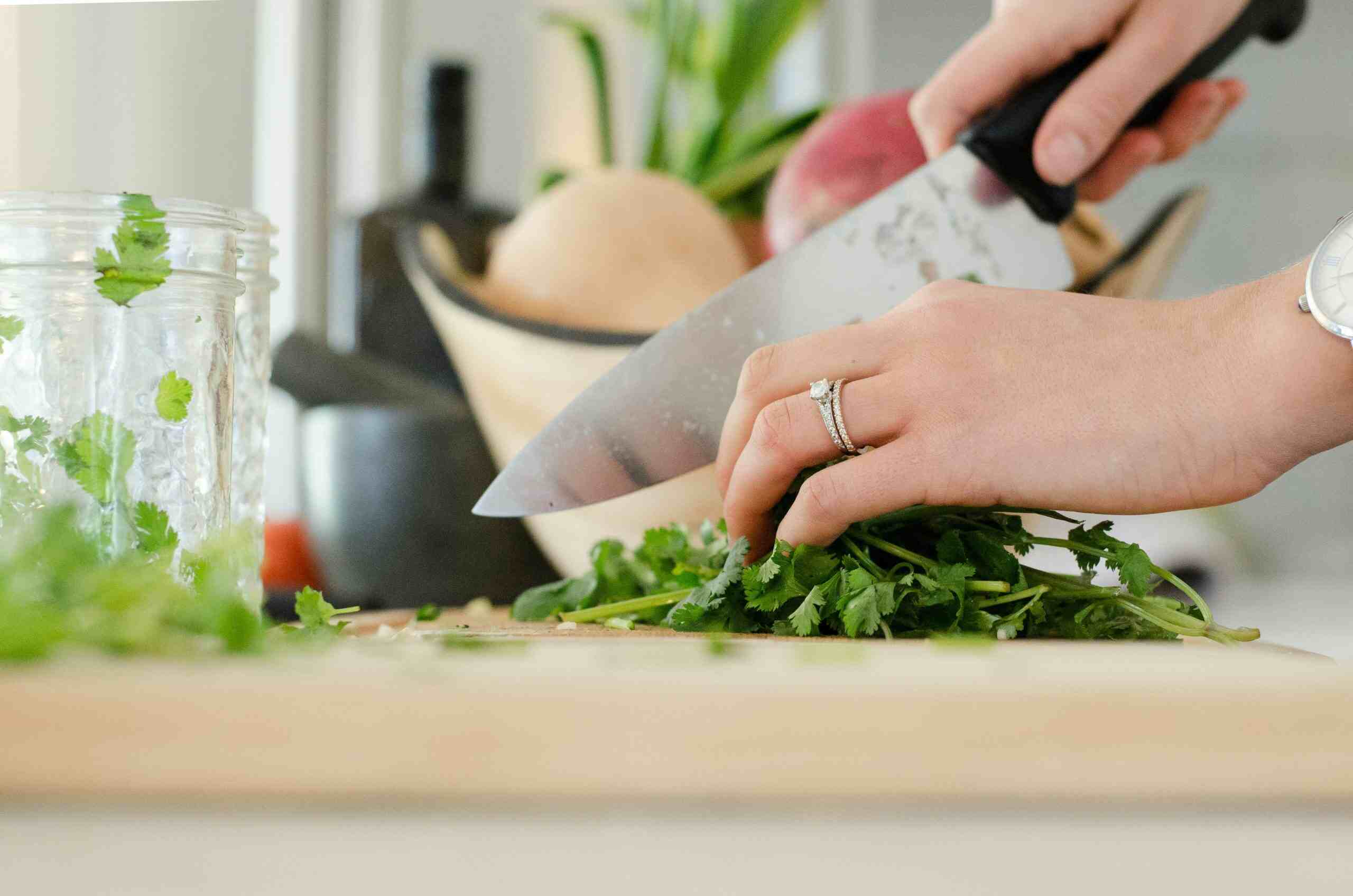Introduction:
Kitchen Tools And Equipments The kitchen is the heart of the home, a place where creativity, comfort, and nourishment come together. To transform a collection of ingredients into a delicious meal, you need more than just skill and recipes—you need the right tools and equipment. From basic essentials to high-tech gadgets, the right kitchen tools make cooking easier, faster, and more enjoyable. Let’s explore the must-have kitchen tools and equipment that every home cook should consider adding to their arsenal.
1.Knives: The Cornerstone of Every Kitchen
A good set of knives is one of the most important investments you can make in your kitchen. A chef’s knife, a paring knife, and a serrated knife are the basic trio that can handle most of your cutting needs. A quality chef’s knife is versatile and ideal for slicing, dicing, and chopping. A paring knife is perfect for intricate work like peeling fruits and vegetables, while a serrated knife is essential for cutting bread and other foods with a hard exterior and soft interior. High-carbon stainless steel knives offer durability, precision, and ease of maintenance, making them an excellent choice for both professional chefs and home cooks.
2.Cutting Boards: Protect Your Surfaces and Your Knives
Cutting boards are essential for food preparation and help protect both your countertops and knives. Wooden boards, especially those made from hardwoods like maple or walnut, are gentle on knife blades and naturally antimicrobial. Plastic cutting boards are another popular option as they are easy to clean and can be safely washed in a dishwasher. Having separate boards for raw meat, vegetables, and cooked foods helps prevent cross-contamination and maintains food safety.
3.Cookware: Pots, Pans, and Beyond
Quality cookware is essential for preparing a wide variety of dishes. A well-rounded set of pots and pans should include a non-stick skillet, a stainless steel frying pan, a saucepan, a sauté pan, a Dutch oven, and a stockpot. Non-stick skillets are ideal for cooking eggs and delicate foods, while stainless steel pans are perfect for searing meats and deglazing. A Dutch oven is a versatile piece that can handle everything from slow-cooked stews to baking bread. Investing in high-quality cookware ensures even heat distribution, durability, and ease of cleaning.
4.Small Appliances: Time-Savers for Busy Kitchens
Small kitchen appliances can significantly cut down preparation time and effort. A high-powered blender is perfect for smoothies, soups, and sauces, while a food processor can handle chopping, slicing, and dicing in seconds. A stand mixer is indispensable for baking enthusiasts, making light work of whipping, kneading, and mixing doughs and batters. Multi-cookers, such as Instant Pots, combine several cooking methods—pressure cooking, slow cooking, steaming, and sautéing—into one compact unit, offering versatility and convenience.
5.Measuring Tools: Precision in Cooking and Baking
Accuracy is key in cooking and baking, making measuring tools a must-have in any kitchen. Measuring cups and spoons are essential for dry and wet ingredients, while a kitchen scale is ideal for recipes that require precision. Digital scales with tare functions allow you to measure ingredients directly in your mixing bowl, reducing the number of dirty dishes and ensuring accuracy.
6.Mixing Bowls: Versatility and Convenience
Mixing bowls are multi-purpose tools that every kitchen needs. Stainless steel bowls are lightweight, durable, and non-reactive, making them suitable for various tasks, from mixing batters to marinating meats. Glass mixing bowls are another great option, as they are microwave-safe and provide a non-porous surface that doesn’t absorb odors or stains. Nesting sets are space-saving and help keep your kitchen organized.

7.Utensils: From Spatulas to Whisks
Kitchen utensils come in all shapes and sizes, each serving a unique purpose. A sturdy set of heat-resistant spatulas, wooden spoons, tongs, ladles, and whisks are essential for everyday cooking tasks. Silicone spatulas are ideal for scraping bowls, stirring sauces, and flipping delicate foods without scratching non-stick surfaces. Whisks come in various sizes, perfect for everything from whipping cream to mixing sauces.
8.Baking Essentials: Pans, Sheets, and Tools
For those who love to bake, having the right tools is essential. Baking sheets, muffin tins, loaf pans, cake pans, and pie dishes are all staples in a baker’s kitchen. Non-stick and silicone bakeware provide easy food release and clean-up, while metal and glass options ensure even baking. Tools like rolling pins, pastry brushes, cooling racks, and cookie cutters add versatility to your baking toolkit.
9.Food Storage: Keep Ingredients Fresh and Organized
Proper food storage extends the shelf life of ingredients and keeps your kitchen organized. Airtight containers, mason jars, and resealable bags are perfect for storing dry goods, leftovers, and prepped ingredients. Clear containers make it easy to see what’s inside, while stackable options save space in your pantry or refrigerator.
10.Innovative Gadgets: The Future of Cooking
Technology continues to revolutionize the kitchen with smart gadgets like sous vide machines, air fryers, and induction cooktops. Sous vide allows for precise temperature control, resulting in perfectly cooked meats and vegetables. Air fryers offer a healthier alternative to deep frying by using hot air circulation to achieve crispy textures with minimal oil. Induction cooktops provide efficient, rapid heating and are safer than traditional gas or electric stovetops.
Conclusion
Equipping your kitchen with the right tools and equipment is an investment in your culinary journey. Whether you’re a novice cook or a seasoned chef, having the right tools can elevate your cooking experience, making meal preparation faster, more efficient, and more enjoyable. From the basics like knives and cutting boards to innovative gadgets like air fryers and sous vide machines, these essential kitchen tools will inspire creativity and help you cook with confidence.
Why is it important to know kitchen tools and equipment?
Understanding kitchen tools and equipment is fundamental for anyone who cooks, whether at home or professionally. The kitchen is a dynamic space where creativity meets functionality, and knowing how to effectively use the right tools can greatly impact your cooking experience. From enhancing safety to improving efficiency, familiarity with kitchen tools and equipment provides numerous benefits that go beyond the basics of preparing meals. Here’s why it is important to know your way around kitchen tools and equipment:
1.Improves Cooking Efficiency and Speed
Knowing which tools and equipment to use can dramatically increase your efficiency in the kitchen. Each tool is designed for a specific purpose—paring knives for peeling, serrated knives for slicing bread, and chef’s knives for chopping vegetables. Using the right tool for the task at hand minimizes preparation time and effort. For example, a food processor can chop, slice, and dice vegetables in seconds compared to manually doing it with a knife. Similarly, a stand mixer can whip cream or knead dough much faster and more consistently than by hand. Understanding the purpose and use of each tool allows you to work smarter, not harder, in the kitchen.
2.Ensures Safety in the Kitchen
Kitchen safety is paramount, and using tools and equipment correctly is a key aspect of preventing accidents. Mishandling knives, using inappropriate tools for specific tasks, or incorrectly operating appliances can lead to injuries. Knowing how to safely use and care for kitchen equipment—such as understanding the proper grip for a chef’s knife, the correct way to use a mandoline slicer, or the safety features of a pressure cooker—can significantly reduce the risk of cuts, burns, and other kitchen mishaps. Proper knowledge also extends to the maintenance and storage of tools, ensuring they remain in safe, working condition.
3.Enhances the Quality of Cooking
Cooking is both an art and a science. Using the correct kitchen tools and equipment not only makes the cooking process smoother but also enhances the quality of the food. The right tools help achieve the desired textures, flavors, and presentations. For instance, a well-seasoned cast iron skillet can create a perfect sear on steaks, while a non-stick pan is ideal for delicate omelets. Baking bread or cakes in the appropriate pan ensures even heat distribution, resulting in better rise and texture. Understanding the role of each piece of equipment allows for better control over cooking outcomes.
4.Encourages Experimentation and Creativity
Knowing your kitchen tools empowers you to experiment with new techniques and recipes. When you are familiar with your equipment, you are more likely to try out new dishes, explore different cuisines, and use varied cooking methods. For example, if you know how to use a sous vide machine, you might explore new ways of cooking meat to perfection. If you’re comfortable with a pasta maker, you may start creating fresh homemade pasta. Confidence with your tools allows you to be more creative and adventurous, expanding your culinary repertoire.
5.Saves Money and Reduces Waste
Proper knowledge of kitchen tools and equipment can lead to cost savings and waste reduction. Understanding how to use tools effectively means less food waste from poorly cut or prepared ingredients. Investing in quality, multipurpose tools like a chef’s knife, a cast iron skillet, or a high-powered blender, rather than a plethora of single-use gadgets, saves money in the long run. Furthermore, knowing how to maintain your tools, such as sharpening knives or seasoning pans, extends their lifespan, preventing the need for frequent replacements.
6.Facilitates Meal Planning and Preparation
Knowledge of kitchen tools can streamline meal planning and preparation. When you know what tools you have and how to use them, you can plan meals that best utilize those resources. For example, if you have a slow cooker, you might plan to make stews or soups in advance. If you own a high-speed blender, you could include smoothies or blended soups in your weekly menu. Understanding your kitchen’s capabilities allows you to efficiently plan and prepare meals, saving time and reducing the stress of daily cooking.
7.Promotes Healthy Cooking and Eating Habits
The right tools can make healthy cooking easier and more appealing. Understanding equipment like steamers, air fryers, or spiralizers allows you to prepare healthier versions of your favorite dishes with less oil, salt, or sugar. An air fryer can give you crispy results without deep frying, while a spiralizer can turn vegetables into a low-carb pasta alternative. Knowing how to use these tools opens up a range of healthy cooking methods, helping you maintain a balanced diet and make healthier choices.
8.Supports Learning and Skill Development
Cooking is a lifelong learning process, and knowing your tools and equipment helps develop and refine your culinary skills. The more you understand your tools, the more you can improve techniques such as knife skills, blending, baking, and sautéing. Mastery of your kitchen equipment also translates to greater confidence in cooking, encouraging continuous learning and growth. This knowledge is particularly beneficial for those looking to take their cooking to the next level, either as a hobby or a professional pursuit.
Conclusion
Knowing kitchen tools and equipment is crucial for anyone looking to improve their cooking skills, ensure safety, and enhance the overall kitchen experience. From improving efficiency and saving money to encouraging creativity and supporting healthy eating, understanding how to use and maintain these tools is fundamental. A well-equipped kitchen is not just about having the latest gadgets; it’s about knowing how to use them to make cooking a more enjoyable, safe, and productive activity. Ultimately, the more familiar you are with your kitchen tools, the more empowered you become to create delicious meals with confidence and ease.
What are the uses of cooking tools and equipment?
Kitchen Tools And Equipments Cooking tools and equipment are essential components of any kitchen, whether for a home cook or a professional chef. Each tool and piece of equipment serves a unique purpose, from the simplest spoon to high-tech appliances like sous vide machines. Understanding the uses of these tools can enhance your cooking efficiency, ensure safety, and elevate the quality of your dishes. Let’s delve into the various uses of different cooking tools and equipment to better understand their importance in the culinary world.
1.Knives: Precision Cutting and Chopping
Knives are arguably the most fundamental tool in the kitchen. They are used for a variety of tasks, including chopping, slicing, dicing, mincing, and carving. Different types of knives have specific uses:
Chef’s Knife: A versatile all-purpose knife perfect for chopping vegetables, slicing meats, and mincing herbs.
Paring Knife: Ideal for peeling fruits, trimming vegetables, and intricate cutting tasks.
Bread Knife: A serrated knife designed to cut through bread and pastries without crushing them.
Boning Knife: Used to separate meat from bones with precision. The proper use of knives ensures uniform cooking of ingredients, enhances presentation, and improves safety by reducing the likelihood of accidents.

2.Cutting Boards: Stable Surfaces for Preparation
Cutting boards provide a stable and sanitary surface for cutting, slicing, and chopping ingredients. They protect countertops from scratches and prevent knives from dulling too quickly. Different materials serve different purposes:
Wooden Boards: Best for cutting fruits, vegetables, and bread. They are gentle on knives and naturally antimicrobial.
Plastic Boards: Ideal for handling raw meat, fish, and poultry because they can be sanitized in a dishwasher. Using separate boards for different types of ingredients helps avoid cross-contamination, promoting food safety.
3.Mixing Bowls: Combining Ingredients with Ease
Mixing bowls are essential for combining ingredients in cooking and baking. They come in various materials, such as stainless steel, glass, and ceramic, each with specific uses:
Stainless Steel Bowls: Lightweight, durable, and ideal for mixing, tossing salads, or whipping.
Glass Bowls: Microwave-safe and non-reactive, perfect for marinating acidic ingredients or melting chocolate.
Ceramic Bowls: Heavy and aesthetically pleasing, often used for serving or mixing dough. The versatility of mixing bowls makes them a staple for any kitchen, useful in both preparation and serving.
4.Cookware: Cooking, Searing, and Simmering
Cookware, including pots, pans, and skillets, is used for cooking, boiling, frying, searing, and simmering. Different types of cookware are suited to different methods of cooking:
Frying Pans and Skillets: Used for sautéing, frying, and browning. Non-stick varieties are ideal for cooking eggs or pancakes without sticking.
Saucepans: Perfect for boiling pasta, making sauces, or reheating soups.
Dutch Ovens: Heavy-duty pots ideal for slow-cooking stews, braising meats, and baking bread.
Stockpots: Large pots used for boiling large quantities of liquid, such as making soups, stocks, and pasta. Quality cookware ensures even heat distribution, reduces the likelihood of burning, and enhances the overall cooking experience.
5.Measuring Cups and Spoons: Ensuring Precision in Cooking and Baking
Measuring cups and spoons are essential tools for accurately measuring both dry and liquid ingredients. Precise measurements are especially important in baking, where the correct proportions determine the final product’s texture and flavor. Measuring tools come in different varieties:
Dry Measuring Cups: Designed to measure ingredients like flour, sugar, and grains.
Liquid Measuring Cups: Typically made of glass or plastic with a spout, used for liquids like water, milk, and oil.
Measuring Spoons: Essential for small quantities of both dry and liquid ingredients like spices, extracts, and oils. Using measuring tools ensures consistency in recipes and helps achieve desired results every time.
6.Utensils: Stirring, Flipping, and Serving
Kitchen utensils come in many shapes and sizes, each designed for specific tasks:
Spatulas: Used for flipping, spreading, and scraping. Silicone spatulas are heat-resistant and safe for non-stick cookware.
Wooden Spoons: Versatile for stirring soups, sauces, and stews without scratching cookware.
Whisks: Ideal for beating eggs, whipping cream, and mixing batters for a smooth, airy texture.
Tongs: Used for flipping, tossing, and serving foods while maintaining control and preventing burns. The proper use of utensils enhances control, safety, and efficiency during cooking and serving.

7.Baking Tools: Shaping, Mixing, and Rolling
Baking tools are essential for anyone who enjoys creating cakes, cookies, bread, and pastries. These tools help achieve the desired textures and shapes:
Rolling Pins: Used for flattening dough to an even thickness.
Pastry Brushes: Perfect for glazing pastries, buttering dough, or applying egg wash.
Baking Sheets and Pans: Used for baking cookies, roasting vegetables, or baking cakes.
Cooling Racks: Allow baked goods to cool evenly, preventing sogginess. Using the right baking tools ensures even cooking, proper texture, and professional-looking baked goods.
8.Small Appliances: Multipurpose Cooking Solutions
Small kitchen appliances, such as blenders, food processors, and slow cookers, offer convenience and versatility:
Blenders: Great for smoothies, soups, sauces, and purees.
Food Processors: Excellent for chopping, slicing, shredding, and mixing dough.
Slow Cookers: Ideal for cooking meals over a long period with minimal effort, perfect for stews, soups, and casseroles.
Air Fryers: Provide a healthier alternative to deep frying by circulating hot air to achieve crispy textures. Small appliances save time, reduce manual effort, and expand cooking possibilities.
9.Thermometers: Ensuring Proper Cooking Temperatures
Kitchen thermometers are used to ensure foods are cooked to safe and optimal temperatures, preventing undercooking or overcooking:
Meat Thermometers: Ensure meats reach the proper internal temperature for safety.
Candy Thermometers: Used for precise temperature control when making candies, caramel, and syrups.
Oven Thermometers: Ensure the oven is at the correct temperature for even cooking and baking. Using thermometers prevents foodborne illnesses and ensures perfect cooking results.
10.Storage Containers: Preserving Freshness and Reducing Waste
Storage containers are essential for preserving the freshness of ingredients and leftovers:
Airtight Containers: Prevent air and moisture from entering, keeping food fresh longer.
Glass Jars: Ideal for storing dry goods like grains, spices, and nuts.
Freezer Bags: Perfect for portioning and freezing meals or ingredients. Proper storage reduces food waste, saves money, and ensures a well-organized kitchen.
Conclusion
Cooking tools and equipment play a crucial role in meal preparation, from cutting and mixing to baking and cooking. Understanding their uses allows for more efficient and enjoyable cooking experiences, ensures safety, and elevates the quality of food. The right tools help you explore new culinary techniques, maintain food safety, and achieve consistent results, whether you’re a beginner or a seasoned chef. With the proper knowledge and use of cooking tools and equipment, your kitchen becomes a well-organized and effective space for creating delicious and healthy meals.
What is the most important piece of kitchen equipment?
Kitchen Tools And Equipments When setting up a kitchen, one of the most critical considerations is identifying the most essential piece of equipment. With so many tools and gadgets available—from high-tech blenders and air fryers to sous vide machines—it can be challenging to pinpoint the single most important piece. However, when it comes down to versatility, everyday use, and impact on the cooking process, the chef’s knife emerges as the most vital piece of kitchen equipment. Let’s explore why the chef’s knife is indispensable, how it compares to other essential kitchen tools, and what makes it stand out as the backbone of any kitchen.
1.Versatility in the Kitchen
The chef’s knife is the most versatile tool in the kitchen. Unlike other specialized knives such as paring knives or bread knives, a chef’s knife can handle almost any cutting task with ease. Its broad blade and sharp edge make it ideal for chopping vegetables, slicing meats, dicing onions, mincing herbs, and even crushing garlic. The ability to perform a wide variety of tasks with a single tool makes the chef’s knife a kitchen workhorse. Whether you are preparing a simple salad, cutting through a thick piece of meat, or finely dicing ingredients for a complex dish, the chef’s knife proves its worth time and again.
2.Foundation for Culinary Skills
A chef’s knife is more than just a tool; it’s a fundamental extension of a cook’s hand. Proper knife skills are the foundation of culinary arts, and learning to use a chef’s knife efficiently is one of the first lessons taught in culinary schools. The technique of holding and maneuvering the knife, mastering different cuts like julienne, brunoise, or chiffonade, and ensuring consistent sizes of ingredients—all start with this essential tool. For any aspiring cook or chef, a good chef’s knife is an investment in skill-building that will pay off in the quality and efficiency of their cooking.
3.Precision and Control
When it comes to cutting and slicing, precision and control are crucial. A well-balanced chef’s knife allows for precise cuts, which ensures uniform cooking of ingredients. Consistent cuts mean that vegetables will cook evenly, meats will have a uniform texture, and dishes will have a professional presentation. The control a chef’s knife provides over other kitchen tools is unparalleled. Its balance and ergonomic handle allow for a firm grip, reducing the risk of slipping and potential injury. This control also translates into efficiency, as the knife becomes an extension of your hand, allowing for faster preparation without sacrificing accuracy.
4.Durability and Longevity
Unlike many other kitchen gadgets that can wear out or become obsolete, a high-quality chef’s knife is built to last a lifetime. With proper care, such as regular honing, occasional sharpening, and appropriate storage, a chef’s knife maintains its edge and remains a reliable kitchen companion for years. This durability makes it a cost-effective choice in the long run compared to other kitchen equipment, which may need frequent replacement or repair. Moreover, knives do not rely on electricity or batteries, making them a dependable tool regardless of circumstances.
5.Comparison with Other Essential Equipment
While other kitchen tools like pots, pans, cutting boards, and small appliances are essential, they don’t match the versatility and daily use of a chef’s knife. For instance:
Pots and Pans: While essential for cooking, they are often task-specific (e.g., a saucepan for boiling, a skillet for frying) and require different sizes for different dishes.
Cutting Boards: These provide a surface for cutting but are useless without a knife.
Blenders and Food Processors: While excellent for specific tasks like blending smoothies or chopping large quantities of ingredients, they are not needed for everyday cooking.
Mixing Bowls and Spoons: Useful for combining ingredients, but they don’t offer the direct impact on ingredient preparation that a knife does.
In comparison, a chef’s knife is used in nearly every cooking scenario, making it more versatile and frequently required than most other tools.
6.Facilitates Creativity and Experimentation
A chef’s knife is also the gateway to culinary creativity and experimentation. When you have a reliable and sharp chef’s knife, you are more likely to experiment with different ingredients and cooking techniques. Trying out new cuisines often starts with preparing ingredients in unique ways, which requires confidence in your primary cutting tool. This tool’s flexibility supports a cook’s ability to be inventive in the kitchen without being hindered by limited equipment capabilities.
7.Portability and Ease of Use
Unlike bulky kitchen equipment that takes up counter space and requires setup, a chef’s knife is compact and easy to store. Its simplicity makes it user-friendly; anyone can pick up a chef’s knife and start using it with minimal instruction. Its portability also makes it the ideal tool for outdoor cooking, picnics, or traveling—places where carrying heavy or complex equipment isn’t practical.
8.Safety and Efficiency
When properly maintained, a chef’s knife is safer than most other cutting tools. Dull knives require more force to cut, increasing the likelihood of slipping and causing injury. A sharp chef’s knife, on the other hand, requires minimal pressure and provides better control. By reducing the risk of accidents and enhancing cutting efficiency, a good chef’s knife ensures a safer cooking environment.
Conclusion
Kitchen Tools And Equipments While many pieces of kitchen equipment are essential for a well-rounded cooking experience, the chef’s knife stands out as the most important. Its versatility, durability, precision, and impact on cooking skills make it an indispensable tool in any kitchen. From simple daily tasks to complex culinary creations, a chef’s knife is the one piece of equipment that can do it all, supporting both novice home cooks and professional chefs in their culinary journeys. Investing in a high-quality chef’s knife is not just about owning a tool; it’s about embracing a central element of cooking that enhances every aspect of the kitchen experience. A juice recipe for high blood pressure: Blend spinach, celery, cucumber, apple, lemon, and ginger for a heart-healthy drink. Enjoy fresh! Traditional Chinese Fried Rice: Stir-fry rice with eggs, veggies, soy sauce, garlic, and green onions for a classic dish.

